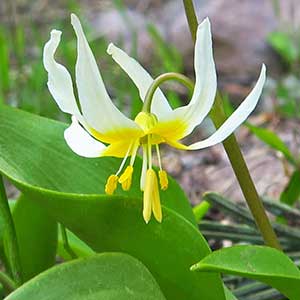Erythronium klamathense
Erythronium rostratum
Klamath fawn-lily
beak trout-lily, yellow fawnlily, yellow troutlily
slender, 25–40 mm.
ovoid, 10–20 mm;
stolons 1–3, common, mostly on 1-leaved, nonflowering plants.
6–17 cm;
blade green, lanceolate to narrowly elliptic, ± folded along midvein, margins entire to wavy.
5–18 cm;
blade green, irregularly mottled, elliptic-lanceolate to ovate or elliptic, ± flat, not glaucous, margins entire.
6–20 cm.
3–10 cm.
1–3-flowered.
1-flowered.
tepals 2/3 or more white, with yellow zone at base, ± pinkish in age, broadly lanceolate, 20–35 mm, inner with small auricles at base;
stamens 8–14 mm;
filaments white, slender;
anthers ± yellow;
style white, 4–9 mm;
stigma ± unlobed.
held erect at anthesis;
tepals yellow, tinged red-purple or orange abaxially, mostly spreading at anthesis, lanceolate, 20–34 mm, inner with conspicuous, well-developed auricles almost encircling opposing filaments;
stamens 13–17 mm;
filaments yellow, lanceolate;
anthers yellow;
pollen yellow;
style persistent, greenish yellow, swollen distally into stigma, tapering gradually proximally to ovary, forming beak on capsule, 8–11 mm;
stigma lobes erect, short, 1 mm.
narrowly obovoid, 2–5 cm.
held erect at maturity on upward-curving peduncle, ellipsoid to ellipsoid-obovoid, 15–25 mm (excluding beak), apex long-beaked.
= 24.
= 24.
Erythronium klamathense
Erythronium rostratum
Erythronium rostratum is found mostly on either side of the Mississippi River embayment, but rarely within it. It often forms extensive colonies where nonflowering, 1-leaved plants far outnumber flowering ones. This is the only species of Erythronium with erect rather than nodding flowers. Some plants at the western limits of the range are triploids (B. L. Carr 1986).
(Discussion copyrighted by Flora of North America; reprinted with permission.)


